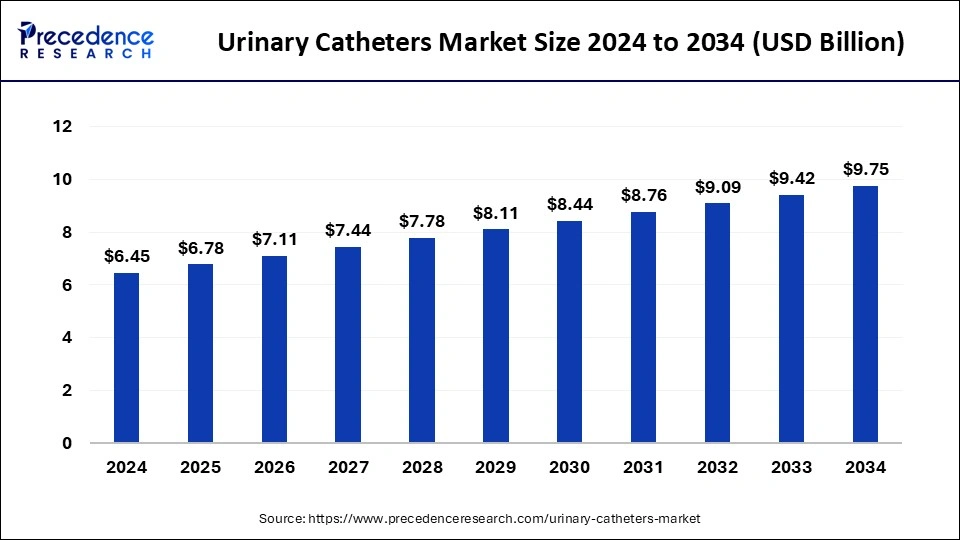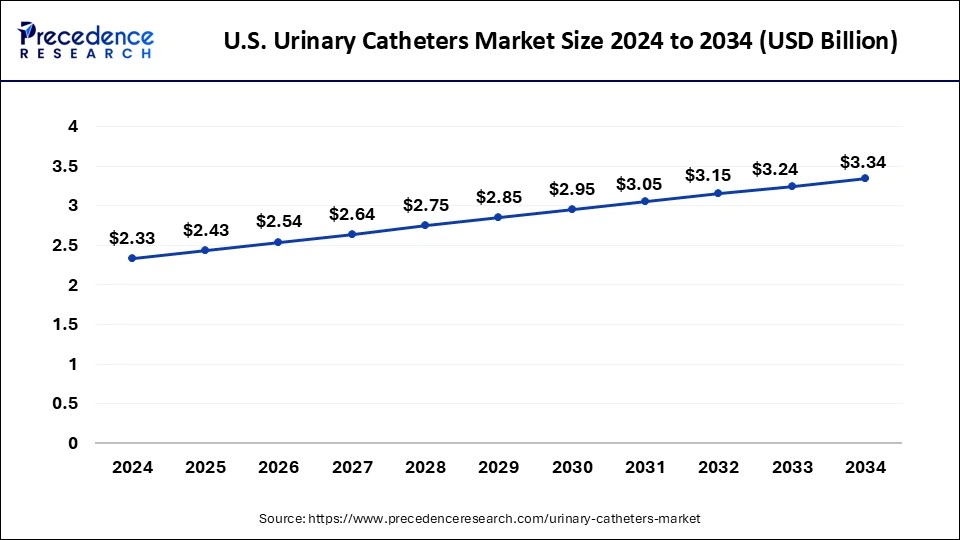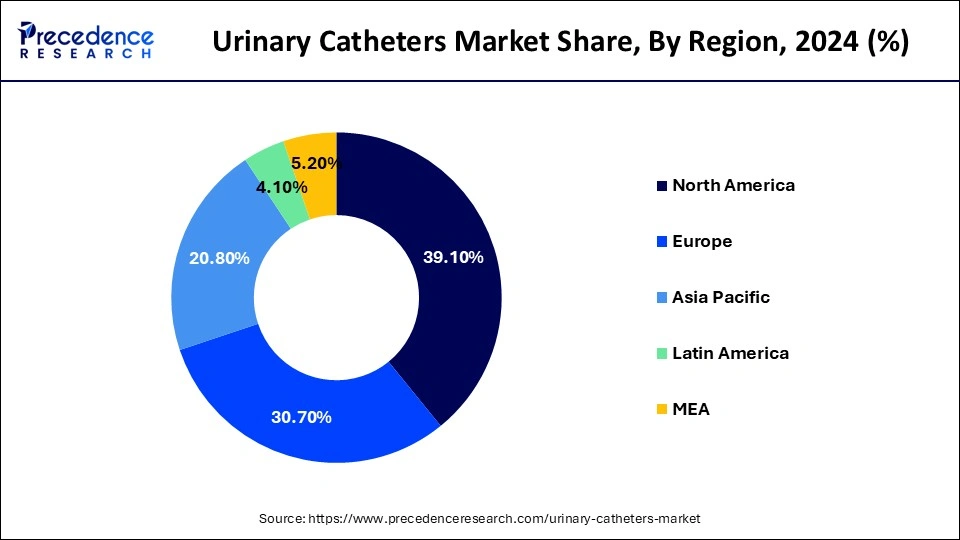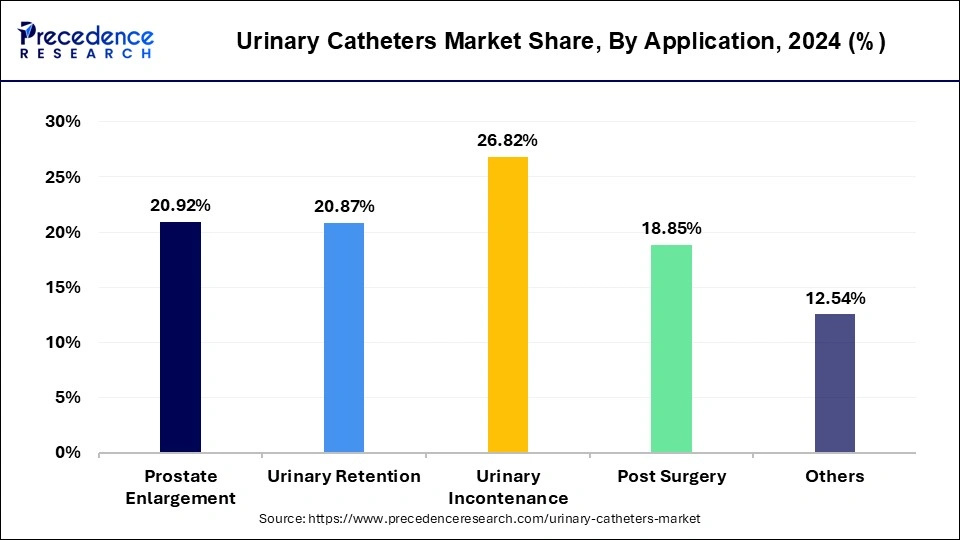Urinary Catheters Market Size and Forecast 2025 to 2034
The global urinary catheters market size accounted for USD 6.45 billion in 2024 and is predicted to increase from USD 6.78 billion in 2025 to approximately USD 9.75 billion by 2034, expanding at a CAGR of 4.10% from 2025 to 2034.

Urinary Catheters MarketKey Takeaways
- In terms of revenue, the global urinary catheters market was valued at USD 6.45 billion in 2024.
- It is projected to reach USD 9.75 billion by 2034.
- The market is expected to grow at a CAGR of 4.10% from 2025 to 2034.
- North America has accounted for more than 39.1% of the market share in 2024.
- By product, the intermittent catheters segment dominated the market with the largest market share of 52.88% in 2024.
- By application, the Urinary Incontinence (UI) segment dominated the market with the largest share of 26.82% in 2024.
- By type, the coated catheters segment led the market in 2024.
- By gender, the women segment led the market in 2024 and promises sustained growth during the forecast period.
- By end-user, the hospitals segment led the market with the largest share in 2024.
U.S.Urinary Catheters Market Size and Growth 2025 to 2034
The U.S. urinary catheters market size was exhibited at USD 2.33 billion in 2024 and is projected to be worth around USD 3.34 billion by 2034, growing at a CAGR of 3.60% from 2025 to 2034.

North America led the global market with the highest market share of 39.1% in 2024. While promising a sustained growth in the urinarycatheters market over the forecast period. Benign Prostate Hyperplasia (BPH), urine retention, bladder blockage, UI, and bladder cancer are among the key disorders that are driving the regional market. Pee urgency and Overactive Bladder (OAB) are frequent in persons 40 years of age and older, according to the National Association for Continence. Urologic disorders rank third among complaints among Americans 65 and older, making up around 47% of all doctor visits. This information comes from the American Society of Nephrology. Similarly, the Canadian Cancer Society reports that 2,600 persons lost their lives to bladder cancer in 2020, compared to 12,200 new cases of the disease.

The Asia Pacific is expected to grow at the highest CAGR in the urinary catheters market during the forecast period. The Asia Pacific region has been experiencing an increase in the ageing population, leading to a higher prevalence of urological conditions and contributing to the demand for urinary catheters. Moreover, the rising incidence of chronic diseases such as diabetes and neurological disorders in the region has contributed to an increased need for urinary catheters.
Market Overview
A urinary catheter is a flexible tube inserted into the urinary bladder through the urethra to assist with draining urine from the bladder. It is a medical device commonly used when a person is unable to empty their bladder naturally or efficiently. The urinary catheters market offers various types of urinary catheters, including indwelling catheters (also known as Foley catheters) that remain in place for an extended period and intermittent catheters, which are used periodically for drainage.
Urinary catheters serve various medical purposes, such as relieving urinary retention, managing incontinence, assisting with bladder emptying during surgery or medical procedures, and monitoring urine output in critically ill patients. It is essential to follow proper hygiene and sterile techniques during catheter insertion to minimize the risk of infections and complications. Medical professionals typically manage the placement and care of urinary catheters to ensure their effectiveness and the well-being of the patient.
Urinary Catheters MarketGrowth Factors
- The ageing population is more prone to conditions such as urinary incontinence and bladder dysfunction, increasing the demand for urinary catheters.
- The prevalence of urological disorders, such as urinary retention, bladder dysfunction, and urinary incontinence, contributes to the demand for urinary catheters, promoting the growth of the urinary catheters market.
- Increasing trends in home healthcare and the preference for self-catheterization have led to a growing demand for catheters that are easy to use and manage at home.
- The use of urinary catheters is common in various surgical procedures, contributing to the growth of the market. Catheters are often used to manage urine drainage during surgeries.
Market Scope
| Report Coverage | Details |
| Growth Rate from 2025 to 2034 | CAGR of 4.10% |
| Market Size in 2025 | USD 6.78 Billion |
| Market Size by 2034 | USD 9.75 Billion |
| Base Year | 2024 |
| Forecast Period | 2025 to 2034 |
| Segments Covered | Product, Application, Type, Gender, and End-user |
| Regions Covered | North America, Europe, Asia-Pacific, Latin America, and Middle East & Africa |
Market Dynamics
Driver
Rising demand for urinary catheters coated with antimicrobials
Thirty to forty percent of nosocomial infections are UTIs, which can cause high rates of morbidity and death as well as extended hospital stays. Patients in hospitals and home care settings frequently utilize urinary catheters, which are frequently connected to the high incidence of CAUTI. To create and release innovative products that facilitate simple insertion and have clinical efficacy, vendors in the urinary catheters market are making significant investments in R&D.
Bard, for instance, provides BARDEX I.C. anti-infective latex Foley catheters with a Bacti-Guard silver alloy coating and BARD hydrogel, which lowers the risk of biofilm formation on the catheters, bacterial infection, and CAUTIs. For the treatment of urine incontinence, Medtronic provides a wide range of silver-coated urological devices. Additionally, Bard's MAGIC3 Antibacterial Hydrophilic Catheter delivers the advantages of nitrofurazone, an antibacterial agent, which dramatically reduces the development of microorganisms that cause urinary tract infections.
Thus, the availability of sophisticated catheters encourages patients and caregivers to use them, which fuels the urinary catheters market's expansion. Consequently, throughout the forecast period, these variables are probably going to drive the expansion of the worldwide urinary catheter market.
Restraint
Stringent regulation
Strict framework criteria and labeling standards have been enforced by regulatory bodies on medical equipment used in urological procedures. Before being approved, these medical devices must pass a safety evaluation to prove their therapeutic value. Urinary catheter growth prospects are anticipated to be hampered by an increase in product recalls. Suppliers producing these goods risk damage to their brand equity in addition to litigation from patients who have used them.
Tight rules will compel suppliers to recall defective products. Therefore, before releasing their devices into the commercial market, manufacturers should concentrate on gathering sufficient clinical data on the safety and effectiveness of their products. Urinary catheter sales may be impacted by the strict rules governing medical supplies and equipment, which might also be a challenge for producers in the market over the projected period. Therefore, throughout the projected period, strict restrictions would impede the growth of the worldwide urinary catheter market.
Opportunity
The introduction of external catheters for women
The newest development in the worldwide urine catheter market is the use of female external catheters. Female external catheters that are secure and simple to use are offered by vendors in this industry. Urinary incontinence is becoming more common; thus, manufacturers are creating new urinary catheters with biocompatible materials and coatings that are user-friendly and enhance patient satisfaction. Many suppliers develop male external catheters.
However, because female external catheters are becoming more and more popular, several companies are currently creating and producing them. This catheter also makes it easier to expel urine quickly and does not require the connection of sticky devices like glue, straps, or tapes. As a result, end users' quick acceptance of these wearable catheters will optimize their sales and support market expansion throughout the projection period. Consequently, throughout the projected time, these elements will propel the expansion of the worldwide urinary catheter market.
Product Insights
The intermittent catheters segment held the dominating share in 2024. The segment growth is attributed to the growing product launch in the industry. For instance, in February 2023, Coloplast introduced the male catheter design to lower the incidence of UTIs. Urinary tract infections pose a serious concern to individuals utilizing intermittent catheters and to the healthcare system overall. The novel intermittent catheter LujaTM tackles these risks.
The external catheters segment is expected to grow at a rapid rate during the forecast period. For male patients, these catheters are a great substitute for other catheters, such as inhabiting catheters, which must be inserted via the urethra. Additionally, male external catheters are the first choice in situations of UI/urine retention for a large number of patients who prefer self-catheterization. In addition, these catheters come in an assortment of sizes and shapes, providing consumers with several options to select from according to their specific requirements. Prominent corporations provide cutting-edge external catheter solutions. For instance, BD (C.R. Bard) offers a unique selection of male catheters, including the ULTRAFLEX male external catheter, which offers a more secure fit than non-silicon sheaths.
Global Urinary Catheters Market Revenue, By Product, 2022-2024 (USD Million)
| Product | 2022 | 2023 | 2024 |
| Indwelling Catheters | 1,842.3 | 1,937.4 | 2,030.9 |
| Intermittent Catheters | 3,079.2 | 3,246.3 | 3,411.5 |
| External Catheters | 891.1 | 949.8 | 1,009.2 |
Application Insights
The Urinary Incontinence (UI) segment captured the largest share of the urinary catheters market in 2024. A third of people have UI, and it affects more women than males, according to the American Urological Association. It is a major factor in the admission of older individuals to long-term care facilities and is one of the primary causes of this kind of care. Numerous reasons, including ageing-related changes to the urinary system, urinary tract infections (UTIs), and other indirect illnesses including diabetes, stroke, cancer, and impaired mobility, can lead to bladder incontinence. Stress and urge incontinence are the two most prevalent forms of urinary incontinence in women.
- For example, the Urology Care Foundation estimates that over 33 million Americans suffer from overactive bladders, and between 25% and 33% of men and women in the country have UI.

Besides, the Benign Prostate Hyperplasia (BPH) & prostate surgeries segment is expected to grow at a significant rate in the urinary catheters market during the forecast period because people are becoming more knowledgeable about BPH and how it affects life quality. Prostate gland enlargement, or BPH, is a prevalent medical disorder that affects male patients 50 years of age and beyond. Urine flow obstructions and other painful urinary symptoms may result from this. Minimally invasive operations can help treat it by relieving the obstruction and urine retention brought on by the prostate and BPH.
- Furthermore, around 294,000 Americans live with spinal cord damage, and 17,810 new cases are diagnosed with spinal cord injury annually, according to the Statistical Centers of National Spinal Cord damage "Figure and Facts at a Glance 2020."
Global Urinary Catheters Market Revenue, By Application, 2022-2024 (USD Million)
| Application | 2022 | 2023 | 2024 |
| Prostate Enlargement | 1,201.4 | 1,275.5 | 1,350.0 |
| Urinary Retention | 1,209.4 | 1,278.1 | 1,346.4 |
| Urinary Incontenance | 1,572.1 | 1,651.8 | 1,730.0 |
| Post Surgery | 1,093.7 | 1,155.0 | 1,215.9 |
| Others | 736.2 | 773.1 | 809.3 |
Type Insights
The coated catheters segment dominated the urinary catheters market in 2024. Coated catheters often feature specialized surfaces aimed at reducing infections and improving patient's comfort. Antibacterial and hydrophilic coatings are common, providing a barrier against microbial colonization and facilitating smoother insertion and removal. These coatings contribute to a lower risk of catheter-associated urinary tract infections and may enhance overall patient satisfaction. On the other hand, the uncoated segment is expected to grow at a rapid rate over the projected period because it is simple in design and cost-effective in nature.
Gender Insights
The women segment dominated the urinary catheters market in 2024. The segment is observed to sustain the position owing to the rising urinary tract infections in women. According to the data published by OASH, women caught UTI up to 30 times more often than men do. In addition, 4 out of 10 women will get UTI at least one more within six months.
End-user Insights
The hospitals segment held the largest share of the urinary catheters market in 2024. Catheters are employed in hospitals for various medical conditions, including surgeries, critical care and long-term patient management. Intermittent and indwelling catheters are commonly used in hospitals settings based on the specific needs of patients. Besides, the clinics segment is expected to experience a substantial growth due to growing pool of patients with chronic conditions.
Recent Developments
- In January 2023, after a thorough authorization procedure, Bactiguard announced the approval of its first MDR (Medical Device Regulations 2017/745) product. The latex BIP Foley Catheter, an indwelling urinary catheter using Bactiguard's exclusive infection prevention technology, is the subject of the MDR approval. A thin coating of noble metal alloy affixed to the catheter's surface serves as the foundation for Bactiguard's unique technology. The metals have a galvanic effect when they come into contact with fluids, which lowers microbial adhesion—that is, fewer germs stick to the catheter surface. Healthcare-associated infections (HAI) impact one in ten patients globally, with catheter-associated urinary tract infections (CAUTI) accounting for a sizable portion of cases. The incidence of CAUTI is considerably decreased by urinary catheters equipped with Bactiguard technology.
- In December 2022, to minimize urinary tract infections (UTIs) and unintentional Foley catheter extractions, CATHETRIX, a creative creator of urinary (Foley) smart catheter fixation devices, commercially debuted their catheter stabilizer at the Arab Health 2023.
Urinary Catheters Market Companies
- Coloplast
- ConvaTec, Inc.
- Boston Scientific Corp.
- BD (C.R. Bard, Inc.)
- Cook Medical
- Medtronic PLC
- Teleflex, Inc.
- B. Braun Melsungen AG
- Hollister, Inc.
- Medline Industries, Inc.
- J and M Urinary Catheters LLC
Segments Covered in the Report
By Product
- Foley/ Indwelling Catheters
- Intermittent Catheters
- External Catheters
By Application
- Urinary Incontinence
- Benign Prostate Hyperplasia & Prostate Surgeries
- Spinal Cord Injury
- Others
By Type
- Coated Catheters
- Uncoated Catheters
By Gender
- Male
- Female
By End-user
- Clinics
- Hospitals
- Long-Term Care Facilities
- Others
`By Geography
- North America
- Europe
- Asia-Pacific
- Latin America
- Middle East and Africa
For inquiries regarding discounts, bulk purchases, or customization requests, please contact us at sales@precedenceresearch.com
Frequently Asked Questions
Ask For Sample
No cookie-cutter, only authentic analysis – take the 1st step to become a Precedence Research client
 sales@precedenceresearch.com
sales@precedenceresearch.com
 +1 804-441-9344
+1 804-441-9344